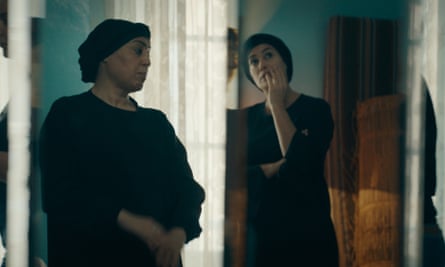Four Daughters, a surreal blend of documentary, memory, meta-fictional re-enactment and therapy now shortlisted for an Oscar, originated years ago: in 2016, when a Tunisian woman named Olfa Hamrouni took to local news to call out her country’s failure to combat the scourge of Isis. And the year before that, when her two radicalized eldest daughters, Ghofrane and Rahma Chikhaoui, fled to join the group in Libya. And the years before that, when Hamrouni struggled to raise her four daughters – the two eldest, rebellious and fiery; the two youngest, keen sponges of conflict – with an iron fist and a housekeeper’s salary.
Hamrouni first caught the eye of Tunisian director Kaouther Ben Hania on the news, pleading with authorities to repatriate her daughters from a Libyan prison in which they’ve been detained on suspicion of terrorist activities (and after a US anti-terror strike killed Rahma’s husband in 2016). Ben Hania was impressed by “her ability to tell her story”, she said. Hamrouni and her two younger daughters, Eya and Tayssir, “have the right words to describe their feelings, their story, their evolution of events”.
Ben Hania, a filmmaker who primarily worked on documentaries, wanted to delve deeper into the story of a family by looking beyond the factual events through a straightforward verité documentary. However, she realized that this format was not enough to capture the complexity and emotions of the situation. This was also agreed upon by Hamrouni. After gaining recognition for her 2020 film, The Man Who Sold His Skin, Ben Hania had numerous options for her next project but decided to revisit Tunisia. She approached Hamrouni and her two daughters with a new idea – hiring actors to portray the missing sisters.
The movie Four Daughters opens with a unique blend of reality and fiction, as well as memories and acting. Eya and Tayssir, who were 11 and 8 when their sisters left, are now in their late teens and meet actors Ichraq Matar and Nour Karoui, who portray characters named Ghofrane and Rahma and wear niqabs. The siblings all acknowledge the striking resemblance between the actors and their sisters. The initial joy of the family reunion quickly turns into tears as Hamrouni is replaced by Tunisian-Egyptian actor Hend Sabri, who plays a double of Hamrouni and consults with her on how to portray her memories. The male roles in the film – including Hamrouni’s neglectful husband and the girls’ alcoholic father, her former boyfriend, and a Tunisian police officer – are all played by a single actor, Majd Mastoura. This casting decision highlights the dispensability of men in this family, as well as being a practical choice.
Ben Hania did not approve of the common practice of re-enactment in documentaries, which often came across as cheap, cheesy, or distracting. She believed it strayed too far from the truth of the matter and was more like fiction than fact. Together with Hamrouni, Eya, and Tayssir, she envisioned a new approach: having the women themselves take part in the re-enactments of their own memories, even directing them. This served as a way for them to seek catharsis, gain clarity, or regain some sense of control through a combination of performance and personal testimony. Ironically, Hamrouni, who had been accused of fabricating her story, felt that having a known actor like Sabri deliver her words would make them more believable. “I wanted to subvert the cliché and use it in a different way,” explained Ben Hania. “We were creating a theatrical scene where we re-enact a memory from the past, bringing it to the present while also questioning its validity.”
The boundaries of the experiment are permeable; the participants’ performances are captured on camera, revealing moments when they break from their roles, time, and even reality. There are occasional news clips of Hamrouni in an aggressive state. Ben Hania includes some behind-the-scenes discussions – a debate between Sabri and Eya about whether cursing is necessary for accuracy (Eya argues that it is); the actors explaining the shift of the headscarf’s meaning in post-revolution Tunisia, from a symbol of resistance to a tool of control; and a conversation between Hamrouni and Sabri about their personal involvement in a painful history. Sabri states, “I have learned to protect myself,” to which Hamrouni responds with a question, “But what if you can’t? What if the character becomes too embedded in your mind and unnerves you because they seem too real?”
The sisters sometimes appear as a close-knit and talkative family, able to discuss topics like waxing or play games about imaginary food. Hamrouni, observing from the doorway, remembers these moments as some of her happiest memories. However, the restagings also reveal a history of pain – marked by sexism, poverty, and forced marriages, Hamrouni raised her daughters with fear of their sexuality. Both Ghofrane and Rahma, who were physically abused and restricted, turned to fundamentalism as a form of liberation. In a scene where Eya carries a knife, both she and Tayssir hint at sexual abuse by Hamrouni’s boyfriend. This revelation unnerves Majd, who is playing the role of the ex-stepfather, causing him to leave. Eya, however, urges him to come back.

Ben Hania described the shoot as an open discussion that took place over four weeks in Tunisia. At times, there were off-camera discussions, restarts, and redirections that required quick reactions from Ben Hania in order to keep the filming on track. She also noted that the shoot was emotionally charged.
Hamrouni stands out as a multifaceted individual, unafraid in her pursuit of her daughters, unapologetically vocal, but also confined by fear when it comes to raising them. She can be both affectionate and harsh, and holds strong religious beliefs while also being skeptical of fundamentalism. According to Ben Hania, she embodies and defends the patriarchal system, but also ends up being its victim.
Strategies for survival, claiming whatever influence is possible, the undeniable impact of male dominance on one’s independence – one can draw similarities to, for example, those who oppose the Equal Rights Amendment in the United States, or women from various cultures who struggle against the very things they represent, and vice versa. “People might assume: ‘Oh, they are Muslim,’ or something like that, but upon closer examination, it is simply a different manifestation of the same issue,” stated Ben Hania.
Unfortunately, there are no definite explanations for why Ghofrane and Rahma departed, only “clues”, according to Ben Hania. The family has also not been able to reunite yet. Ben Hania, her team, and Hamrouni have been persistently urging the Tunisian government to bring back the sisters and Ghofrane’s daughter Fatma, who is now eight years old and has spent her entire life in captivity. Ghofrane and Rahma have not watched the movie but have been briefed by their sisters over the phone. The film’s ending suggests that Hamrouni, Eya, and Tayssir are still hopeful for their return. In the meantime, in Four Daughters, they try to find whatever solace they can.
-
The movie Four Daughters can now be rented online in the US and will be released in the UK on March 22nd.
Source: theguardian.com


